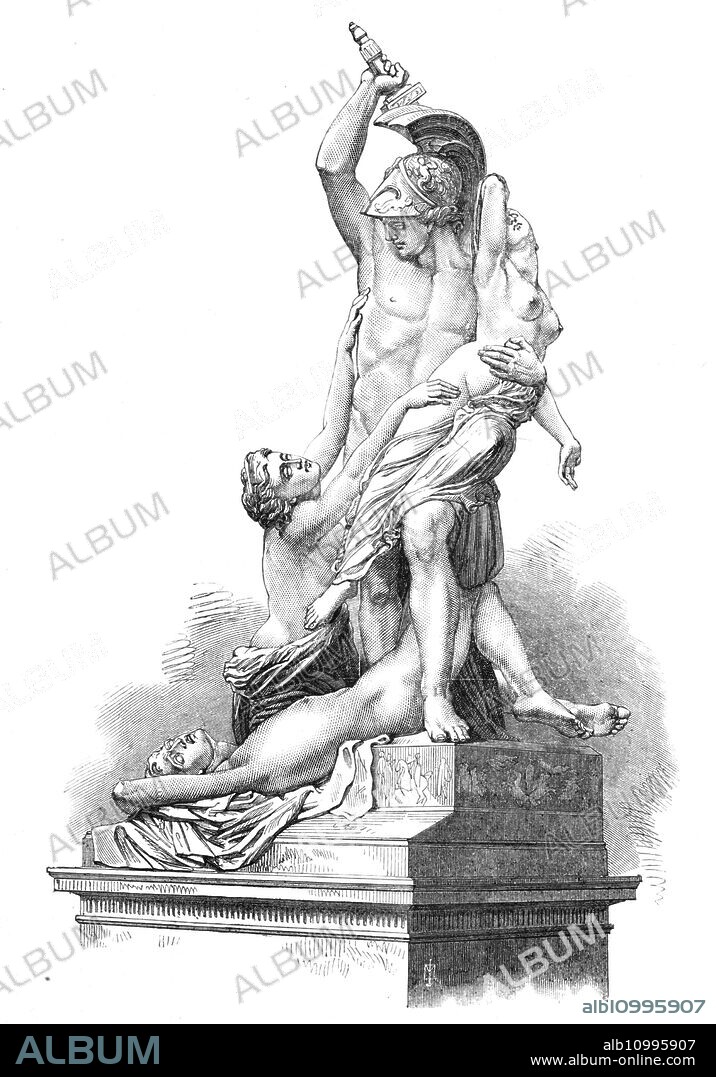alb10995907
The Rape Of Polyxena, by Professor Pio Fedi, in the Loggia at Florence, 1868. Creator: Unknown.

|
Añadir a otro lightbox |
|
Añadir a otro lightbox |



¿Ya tienes cuenta? Iniciar sesión
¿No tienes cuenta? Regístrate
Compra esta imagen.
Selecciona el uso:

Título:
The Rape Of Polyxena, by Professor Pio Fedi, in the Loggia at Florence, 1868. Creator: Unknown.
Descripción:
Ver traducción automática
The Rape Of Polyxena, by Professor Pio Fedi, in the Loggia at Florence, 1868. 'The subject is taken from the accounts by Virgil in the AEneid, and Euripides in his "Hecuba;" but the sculptor, for greater effect, has combined several tragic events, which are scattered in various parts of the poem and drama, supposing as simultaneous the occurrences which happened at intervals. To avenge the treacherous slaughter of Achilles, which was planned by Hecuba, Pyrrhus having already slain Priam and Polites, afterwards sacrificed Polyxena to appease the wrathful shade of the murdered warrior. The group of Fedi, however, represents Pyrrhus tearing Polyxena from the arms of Hecuba, whilst the lifeless form of the young Polites is stretched at his feet. The maternal anguish of Hecuba, the supplicating terror of the young maiden, the fierce exultation of the warrior, and the convulsive agonies of a violent death, are all rendered in a masterly manner, whilst the contrasts of age and forms between the mature womanhood of Hecuba and the girlish grace of Polyxena's figure - between the nervous vigour of manhood in Pyrrhus and the delicate, boyish beauty of Polites are admirably managed'. From "Illustrated London News", 1868.
Crédito:
Album / The Print Collector/Heritage Images
Autorizaciones:
Modelo: No - Propiedad: No
¿Preguntas relacionadas con los derechos?
¿Preguntas relacionadas con los derechos?
Tamaño imagen:
2527 x 3612 px | 26.1 MB
Tamaño impresión:
21.4 x 30.6 cm | 8.4 x 12.0 in (300 dpi)
Palabras clave:
ANCIENT GREEK • ANTIGUA GRECIA • ARMA GRIEGA • ARMA • ARMADURA • ARMADURAS • ARMAS • ARTE • ARTES • ASPA • BLANCO Y NEGRO • BRITANICO • CASCO • CHICO • CONCEPTO • CONFLICTO BELICO • CORAZA • CRIMEN • CRIMINAL • DELINCUENTE • DESNUDA • DESNUDAS • DESNUDEZ • DESNUDO • DESNUDOS • ESCULTURA • ESPADA • ESPADAS • ESTATUA • ESTATUAS • GENTE • GRABADO • GRAN BRETAÑA • GRECIA ANTIGUA • GRECIA • GRIEGO ANTIGUO • GUERRA • HOMBRE • HOMBRES • ILLUSTRATED LONDON NEWS • IMPRESION • ITALIA • ITALIANO • LEY • MARBLE • MARMOL • MASCULINO • MITOLOGIA GRIEGA • MITOLOGIA • MONARCA • MUJER • MUJERES • NEOPTÓLEMO • PAÍS • PERIODICO • PIEDRA • PIEDRAS • PIRRO • PRENSA • REAL (REALEZA) • REALEZA • REINA • RETRATO DE HOMBRE • ROCA • S. XIX • SECUESTRADOR • SIGLO XIX • SIGLO • SOBERANO • STATUE • THE ILLUSTRATED LONDON NEWS • VIOLENCIA • VIOLENTOS • WAR • WEAPON
 Pinterest
Pinterest Twitter
Twitter Facebook
Facebook Copiar enlace
Copiar enlace Email
Email
